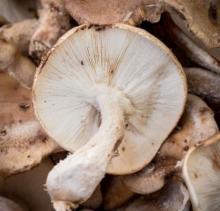A shiitake mushroom extract called lentinan did not improve overall survival in advanced gastric cancer when added to the oral fluoropyrimidine S-1 in a randomized, controlled phase III trial.
Patients also experienced treatment failure significantly earlier on lentinan/S-1 than on S-1 monotherapy, Shigefumi Yoshino, MD, of Yamaguchi University Graduate School of Medicine in Ube, Japan, and his associates reported online August 5 in the European Journal of Cancer. “The present study showed no efficacy of lentinan administration combined with S-1 treatment in patients with unresectable or recurrent gastric cancer,” they concluded.
Lentinan, a purified beta-1, 3-glucan from Lentinus edodes (shiitake mushroom) has been shown to boost immune response and humoral antitumor immunity in mice and humans. S-1, a combination of tegafur, gimeracil, and potassium oxonate, is the most widely used therapy for unresectable or recurrent gastric cancer in Japan, the researchers noted. Based on promising results from a pilot trial, they conducted a prospective, multicenter, open-label phase III trial of 309 adults with unresectable or recurrent gastric cancer who were randomly assigned to receive S-1 with lentinan or S-1 alone. “S-1 was given orally twice daily for the first 4 weeks of a 6-week cycle,” they noted. “The dose of S-1 administered was calculated according to the patient’s body surface area as follows: less than 1.25 m2, 40 mg; 1.25-1.5 m2, 50 mg; and greater than 1.5 m2, 60 mg.” Lentinan was given intravenously at a dose of 2 mg weekly. Patients continued treatment until progressive disease, unacceptable toxicity, withdrawal of consent, or a decision to stop treatment by the treating physician (Eur J Cancer. 2016;65:164-71). The S-1 group received a median of three treatment cycles, while the S-1/lentinan group received a median of two S-1 cycles and 22 lentinan infusions, the investigators reported. Median overall survival was statistically similar between the arms (13.8 months with S-1 monotherapy and 9.9 months with combination therapy; P = 0.21). Median time to treatment failure was significantly longer with S-1 alone than with S-1 plus lentinan (4.3 and 2.6 months (P less than 0.001). Overall response rates were 22.3% with S-1 alone and 18.7% with S-1/lentinan combination therapy.
Lentinan did not yield significant safety signals, nor did it seem to affect quality of life, the researchers noted. Patients with relatively higher percentages of lentinan-binding monocytes (that is, at least 2%) who received more than two cycles of chemotherapy did survive significantly longer with lentinan plus S-1 than with S-1 alone, they reported. Within this subgroup, 24% of lentinan/S-1 patients were still alive at 3 years, compared with 3% of patients given S-1 monotherapy. Thus, a patient’s percentage of lentinan-binding monocytes might help predict response to lentinan, the researchers concluded.
The Japanese Foundation for Multidisciplinary Treatment of Cancer funded the study. Dr. Yoshino disclosed personal fees outside the current study from MSD, Taiho, and Chugai.


